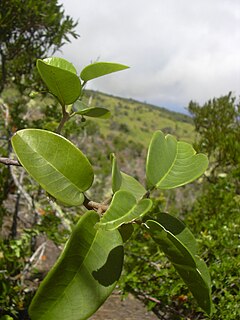
Melicope is a genus of about 230 species of shrubs and trees in the family Rutaceae, occurring from the Hawaiian Islands across the Pacific Ocean to tropical Asia, Australia and New Zealand. Plants in the genus Melicope have simple or trifoliate leaves arranged in opposite pairs, flowers arranged in panicles, with four sepals, four petals and four or eight stamens and fruit composed of up to four follicles.

Nepticulidae is a family of very small moths with a worldwide distribution. They are characterised by eyecaps over the eyes. These pigmy moths or midget moths, as they are commonly known, include the smallest of all living moths, with a wingspan that can be as little as 3 mm in the case of the European pigmy sorrel moth, but more usually 3.5–10 mm. The wings of adult moths are narrow and lanceolate, sometimes with metallic markings, and with the venation very simplified compared to most other moths.
Melicope balloui, also called Ballou's melicope or rock pelea, is a species of plant in the family Rutaceae. It is endemic to the Hawaiian Islands. It is threatened by habitat loss. Like other Hawaiian Melicope, this species is known as alani.
Melicope haleakalae, Haleakala melicope, is a species of plant in the family Rutaceae. It is endemic to the Hawaiian Islands.
Melicope haupuensis is a species of tree in the family Rutaceae known by the common names Haupa Mountain melicope and Pacific pelea. It is endemic to the Hawaiian Islands, where it is known only from the island of Kauai. It is threatened by habitat loss. It is a federally listed endangered species of the United States. Like other Hawaiian Melicope, this species is known as alani.

Melicope knudsenii, commonly known as Olokele Valley melicope or Knudsen's melicope, is a species of flowering plant in the family Rutaceae, that is endemic to Hawaii. It inhabits montane mesic forests dominated by Acacia koa, Metrosideros polymorpha, and Dicranopteris linearis on Kauaʻi and East Maui (Auwahi). Associated plants include Syzygium sandwicensis, Cheirodendron trigynum, Myrsine lessertiana, Ilex anomala, Alphitonia ponderosa, Zanthoxylum dipetalum, Kadua terminalis, Pleomele aurea, Bobea spp., Tetraplasandra waimeae, Xylosma hawaiiense, Eurya sandwicensis, Psychotria mariniana, Melicope anisata, Melicope barbigera, Pouteria sandwicensis, Dodonaea viscosa, and Dianella sandwicensis. It is threatened by habitat loss. Like other Hawaiian Melicope, this species is known as alani. This is a federally listed endangered species of the United States.
Melicope ovalis, the wild pelea or Hana melicope, is a species of tree in the family Rutaceae. It is endemic to Maui, of the Hawaiian Islands.
Melicope pallida, the pale melicope, is a species of tree in the family Rutaceae. It is endemic to the Hawaiian Islands. It is threatened by habitat loss. It is a federally listed endangered species of the United States. Like other Hawaiian Melicope, this species is known as alani.

Melicope paniculata, the Lihue melicope, is a rare species of tree in the family Rutaceae. It is endemic to the Hawaiian Islands. Like other Hawaiian Melicope, this species is known as alani.
Melicope puberula, the hairy melicope, is a species of plant in the family Rutaceae. It is endemic to the Hawaiian Islands. Like other Hawaiian Melicope, this species is known as alani. In 2010 it was added to the endangered species list of the United States.
Melicope waialealae is a species of flowering plant in the family Rutaceae that is endemic to the island of Kauai in Hawaii.
Melicope zahlbruckneri, with the common names Zahlbruckner's melicope, Zahlbruckner's pelea, and kipuka piaula, is a species of tree in the family Rutaceae.
Platydesma is a genus of plants in family Rutaceae. Evidence from 2009 indicates that Platydesma is nested within the related genus Melicope and is sister to all Hawaiian Melicope species. And while Melicope species are dioecious, the flowers of Platydesma are hermaphroditic, suggesting a rare evolutionary reversion away from dioecy in Platydesma. While they have no medicinal purposes; the board of water supply states that they can be used for a shrub. Species include:
Paralopostega callosa is a moth of the family Opostegidae. It was first described by Otto Swezey in 1921. It is endemic to the Hawaiian island of Oahu, where it is thought to be widespread in the Koʻolau Range.
Paralopostega dives is a moth of the family Opostegidae. It was first described by Lord Walsingham in 1907. It is endemic to the Hawaiian island of Kauai.
Paralopostega filiforma is a moth of the family Opostegidae. It was first described by Otto Swezey in 1921. It is endemic to the Hawaiian island of Oahu.
Paralopostega peleana is a moth of the family Opostegidae. It was first described by Otto Swezey in 1921. It is endemic to the Hawaiian islands of Oahu and possibly Kauai.
Paralopostega serpentina is a moth of the family Opostegidae. It was first described by Otto Swezey in 1921. It is endemic to the Hawaiian islands of Oahu and possibly Kauai.

Melicope adscendens is a rare species of flowering plant in the citrus family known by the common name auwahi melicope. It is endemic to Hawaii, where it is known only from the island of Maui. It is a federally listed endangered species of the United States. Like other Hawaiian Melicope, this species is known as alani.
Melicope lydgatei is a rare species of flowering plant in the citrus family known by the common names Koolau Range melicope and Lydgate's pelea. It is endemic to Hawaii, where it is known only from the Koolau Range on the island of Oahu. It is a federally listed endangered species of the United States. Like other Hawaiian Melicope, this species is known as alani.




